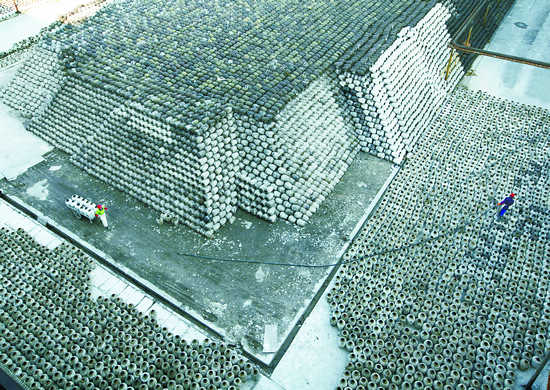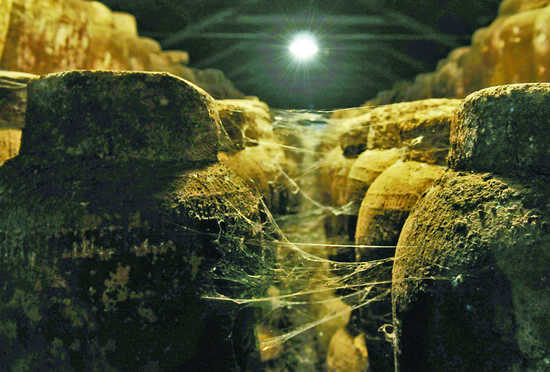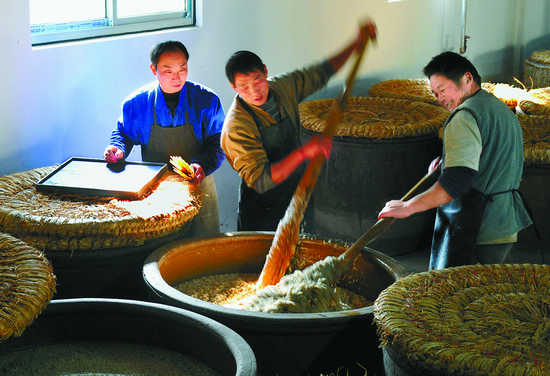Yellow treasure
Updated: 2012-05-13 09:11
(China Daily)
|
||||||||
 |
|
Pressing, filtering, blanching the rice ... Shaoxing's winemakers have made their wines the same way for generations. [Photo/China Daily] |
For Shaoxing's famous wine-makers, it's prime time. Photographer Wang Yuanchang savors the heritage wines.
April is the busiest season for Tian Jiaben, a senior villager living near the source of Jianhu Lake, in Shaoxing, eastern Zhejiang province.
Thirty-six crystal-clear streams formed by mountain springs feed the lake, which has become the heart of production for the world-famous Shaoxing yellow rice wine.
These days, winemaking master Tian is working in his backyard, which is crowded with rows of wine pots.
After he presses fermented sticky rice in a huge wooden tank, the wine flows slowly through bamboo tubes into the wine pots. Suddenly, a sweet smell fills the air.
Tian bends down and scoops some wine with a small bowl, and sips.
"The quality of the wine dictates how long the wine can stay in the cellar," Tian says. "If its quality is not good enough, the longer it stays in the cellar, the more sour it becomes."
Once he's put the new wine into the pots, he will first cover the mouths with lotus leaves, seal them with mud, and then spray some lime water on the surfaces of the pots.
Next, the wine pots are buried in dried rice straw.
"The climate, weather, water, sticky rice, and detailed skills make the process a complex formula," he insists. Success requires "rich experience and high quality raw materials".
The 65-year-old has been making this wine for five decades. Like Tian, hundreds of local winemakers are working double time to produce yellow rice wine.
The winemakers use methods that have changed little from the way their ancestors worked thousands of years ago. In 2006, the process of making Shaoxing yellow rice wine was listed as intangible cultural heritage under State protection.
For local villagers, the aromatic local specialty is more than a beverage. It's also used for medicine, cooking and as a gift.
Every year, when flowers are blooming and trees turn green, it's time to take out jars of sticky rice that have fermented during the whole winter and early spring. After about 90 days of pressing, filtering, and blanching the rice, the workers have a sweet-smelling prize to package for travel around the world.
Contact the writer at sundayed@chinadaily.com.cn.
 |
|
Pressing sticky rice in wooden tanks is the first step in a long process. [Photo/China Daily] |

 Relief reaches isolated village
Relief reaches isolated village
 Rainfall poses new threats to quake-hit region
Rainfall poses new threats to quake-hit region
 Funerals begin for Boston bombing victims
Funerals begin for Boston bombing victims
 Quake takeaway from China's Air Force
Quake takeaway from China's Air Force
 Obama celebrates young inventors at science fair
Obama celebrates young inventors at science fair
 Earth Day marked around the world
Earth Day marked around the world
 Volunteer team helping students find sense of normalcy
Volunteer team helping students find sense of normalcy
 Ethnic groups quick to join rescue efforts
Ethnic groups quick to join rescue efforts
Most Viewed
Editor's Picks

|

|

|

|

|

|
Today's Top News
Health new priority for quake zone
Xi meets US top military officer
Japan's boats driven out of Diaoyu
China mulls online shopping legislation
Bird flu death toll rises to 22
Putin appoints new ambassador to China
Japanese ships blocked from Diaoyu Islands
Inspired by Guan, more Chinese pick up golf
US Weekly

|

|








